1 of 32
Downloaded 36 times
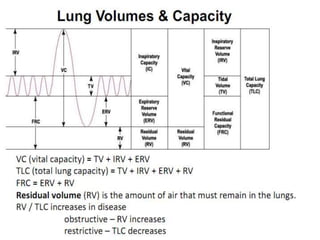
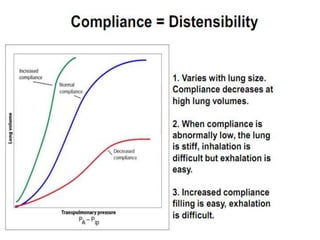
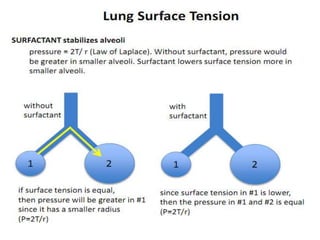
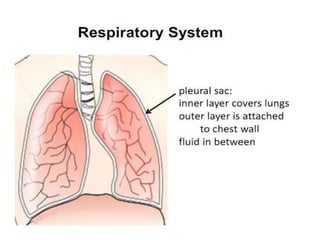
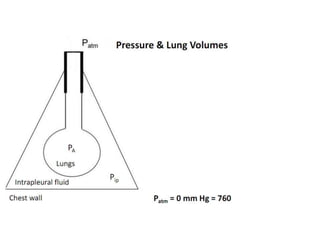
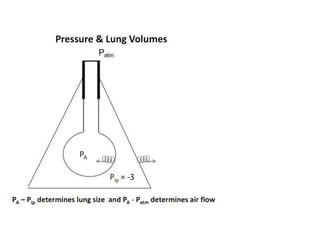
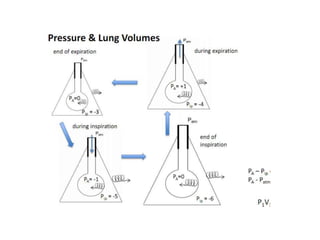
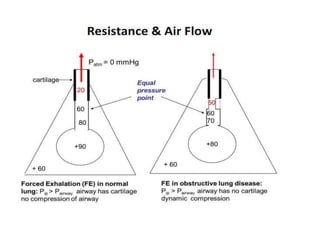



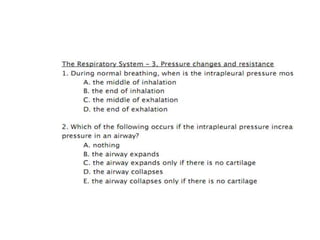


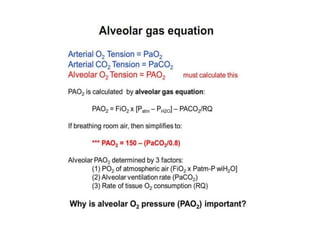
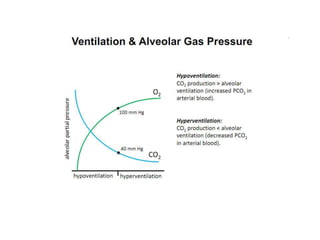
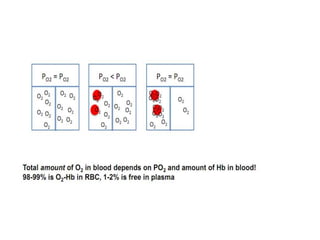


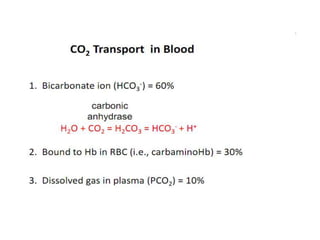
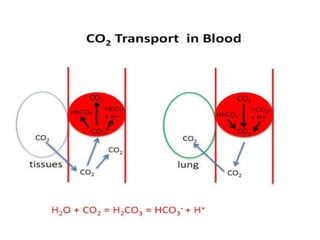











Ad
Recommended
Lung capacity, tidal volume and mechanics of breathing
Lung capacity, tidal volume and mechanics of breathingmohamed alsawaf
Ã˝
The document discusses various aspects of the respiratory system in humans and birds, detailing concepts such as breathing control, tidal volume, and lung capacities. It highlights the roles of the medulla and pons in regulating respiration rates in response to CO2 levels and discusses the mechanics of inhalation and exhalation. Additionally, it includes questions related to respiratory physiology and the effects of exercise on lung function.Obstructive vs. Restrictive Lung disease
Obstructive vs. Restrictive Lung diseaseFatima Awadh
Ã˝
This document discusses the differences between restrictive and obstructive lung diseases. Restrictive lung diseases are characterized by a reduction in total lung capacity below 80% of predicted value, while obstructive lung diseases are characterized by a reduction in airflow, seen through a decreased forced expiratory volume in 1 second and ratio of forced expiratory volume to forced vital capacity. Key lung volumes and capacities such as tidal volume, inspiratory reserve volume, and residual volume are also defined.Obstructive and restrictive of lung disease
Obstructive and restrictive of lung diseaseHAMAD DHUHAYR
Ã˝
This document discusses the key differences between obstructive and restrictive lung diseases. Restrictive lung diseases decrease total lung capacity due to reduced lung compliance from parenchymal disease or other factors. They cause parallel decrements in forced residual capacity, residual volume, and vital capacity. Obstructive lung diseases cause airway closure at higher lung volumes due to inflammation and loss of tissue recoil. They are characterized by an increased residual volume as more gas gets trapped, an increased functional residual capacity, and a decreased vital capacity as residual volume increases more than total lung capacity. Obesity primarily affects functional residual capacity through reduced outward recoil of the chest wall.Lung volume and capacities
Lung volume and capacitiesYogesh Ramasamy
Ã˝
This document discusses lung volumes and lung capacities, which refer to the volume of air associated with different phases of the respiratory cycle. It outlines the four main lung volumes - tidal volume, inspiratory reserve volume, expiratory reserve volume, and residual volume. It then discusses various lung capacities, which are combinations of two or more lung volumes, including inspiratory capacity, expiratory capacity, functional residual capacity, vital capacity, and total lung capacity. The document provides normal values for males and females for these volumes and capacities.obstructive & restrictive lung disease
obstructive & restrictive lung diseasedrghaida
Ã˝
This document discusses the treatment of acute exacerbations of asthma and COPD. For asthma, treatment involves high doses of inhaled bronchodilators, systemic corticosteroids, oxygen therapy, and intravenous fluids. For COPD, treatment focuses on oxygenation, ventilation support using non-invasive ventilation if needed, nebulized short-acting bronchodilators, corticosteroids, and antibiotics for bacterial infections. Lung volumes measured via spirometry can differentiate obstructive disorders like COPD and asthma from restrictive disorders. Obstructive disorders show reduced airflow and FEV1/FVC ratio, while restrictive disorders have normal ratio but reduced lung volumes. Emergent tests for diagnosis include ECG, arterial blood gases,Lecture fermented foods
Lecture fermented foodsthe university of lahore
Ã˝
This document summarizes 7 commonly consumed fermented foods, including their health benefits. Kombucha contains various microorganisms that support gut health. Sauerkraut has been shown to benefit brain health such as depression and anxiety. Pickles are a familiar gateway fermented food that many people enjoy and provide probiotics. Coconut yogurt is a dairy-free source of enzymes and probiotics. Miso is nutrient-dense and full of probiotics. Tempeh is a complete protein containing all essential amino acids. Kimchi can enhance digestion, boost energy, and improve skin health.Acid base controle
Acid base controlethe university of lahore
Ã˝
The kidney maintains pH balance by regulating interrelated cells in the distal convoluted tubule (DCT) and collecting duct (CD) that make ammonium ions and new bicarbonates. These regions of the kidney also excrete fixed acids and new bicarbonates.Human respiration
Human respirationthe university of lahore
Ã˝
Human respiration involves breathing in oxygen and breathing out carbon dioxide. The respiratory system includes the nose, pharynx, larynx, trachea, bronchi, bronchioles, and alveoli. In the alveoli, oxygen from the air diffuses into blood capillaries and carbon dioxide from the blood diffuses out, allowing for gas exchange. Respiration is essential for providing oxygen to cells and removing carbon dioxide waste.Antigen Antibody techniques 6 lecture
Antigen Antibody techniques 6 lecturethe university of lahore
Ã˝
Antigen and antibody interaction is the basis of serological testing. There are several types of serological tests that detect this interaction, including precipitation, agglutination, hemagglutination, enzyme-linked immunosorbent assay (ELISA), Western blot, hemagglutination inhibition, and immunofluorescence. These tests exploit the formation of antigen-antibody complexes to diagnose diseases, identify pathogens, and detect proteins.Vitamin b12 deficiency common in primary hypothyroidism
Vitamin b12 deficiency common in primary hypothyroidismthe university of lahore
Ã˝
This document summarizes a study examining vitamin B12 deficiency in patients with primary hypothyroidism. The study found:
1) Nearly 40% of the 116 hypothyroid patients studied had low vitamin B12 levels, indicating a high prevalence of B12 deficiency in this group.
2) Common symptoms of B12 deficiency like numbness and impaired memory were seen in both B12 deficient and sufficient hypothyroid patients, making symptoms a poor guide to determining B12 status.
3) Treatment with B12 injections led to reported improvement in symptoms in over half of B12 deficient patients, and some non-deficient patients also reported improvement, suggesting a possible placebo effect.
The study concludes that5th immunoglobulins 2 oct 2014
5th immunoglobulins 2 oct 2014the university of lahore
Ã˝
This document summarizes the key features of the five classes of antibodies (immunoglobulins): IgG, IgM, IgA, IgD, and IgE. It describes their structure (monomer, dimer, pentamer), percentage in serum, locations, half-lives, ability to activate complement, placental transfer, and known functions such as enhancing phagocytosis, neutralizing pathogens, and mediating allergic reactions. IgG is the most abundant antibody and has subclasses with varying abilities to activate complement and bind Fc receptors. IgM is the first antibody produced during infection. IgA provides protection to mucosal surfaces. IgD and IgE have more specialized roles in initiating immune responses and allergies,TSH hormone
TSH hormonethe university of lahore
Ã˝
TSH, a glycoprotein hormone, is composed of alpha and beta subunits that determine receptor specificity. TSH is secreted from the pituitary gland in response to TRH stimulation from the hypothalamus. TRH binds to its receptor, activating a phospholipase C signaling cascade involving IP3, DAG, and calcium, which ultimately leads to increased TSH transcription, translation, and secretion. In the thyroid gland, TSH binding activates adenylate cyclase and increases cAMP, stimulating gene expression and thyroid hormone production and release. TSH levels are regulated by negative feedback from thyroid hormone levels and stimulation by TRH. Chronic TSH receptor stimulation can cause hyperthyroidism as seen in Graves' disease.Organ and tissues of immune system
Organ and tissues of immune systemthe university of lahore
Ã˝
The document summarizes the key organs and tissues of the immune system. It discusses the primary lymphoid organs of bone marrow and thymus, where lymphocytes mature. It also describes the secondary lymphoid organs of lymph nodes, spleen, and lymphoid tissues like Peyer's patches and tonsils, which are the sites where immune responses occur. Mucosal-associated lymphoid tissues contain aggregates of immune cells that defend against antigens entering mucosal surfaces.Immune cells 3rd lecture
Immune cells 3rd lecturethe university of lahore
Ã˝
Cells of the immune system can be categorized as cells of the innate immune system or cells of the adaptive immune system. Cells of the innate immune system include phagocytes such as macrophages, neutrophils, dendritic cells, and basophils and mast cells. Cells of the adaptive immune system include lymphocytes such as B cells and T cells. B cells are involved in antibody production while T cells include cytotoxic T cells and helper T cells that activate other immune cells. Natural killer cells are also lymphocytes that help identify and destroy tumor or virus infected cells.introduction to Immunology 1st and 2nd lecture
introduction to Immunology 1st and 2nd lecturethe university of lahore
Ã˝
This document provides an introduction to immunology. It defines immunology as the study of the immune system and its functions in health and disease. The immune system recognizes, attacks, and remembers pathogens that enter the body using innate and adaptive defenses. Key events in immunology history are described, such as Edward Jenner's discovery of vaccination and the eradication of smallpox. Components of the immune system like antibodies, lymphocytes, and the complement system are introduced. The document also distinguishes between innate immunity, which provides non-specific defenses, and adaptive immunity, which has memory and specificity.important of creatine kinase enzyme
important of creatine kinase enzymethe university of lahore
Ã˝
This document discusses creatine kinase (CK), an enzyme that plays an important role in energy metabolism. It has three isoenzymes - CK-MM found mainly in skeletal muscle, CK-MB found in heart muscle, and CK-BB found primarily in brain and smooth muscles. CK levels are measured to diagnose conditions like heart attack, muscle damage, and brain injury. An elevated CK level suggests muscle or tissue damage, with each isoenzyme rising in response to damage in its specific tissues. The test is also used to monitor muscle diseases and can be affected by exercise, medications, toxins, and other clinical factors.More Related Content
More from the university of lahore (12)
Human respiration
Human respirationthe university of lahore
Ã˝
Human respiration involves breathing in oxygen and breathing out carbon dioxide. The respiratory system includes the nose, pharynx, larynx, trachea, bronchi, bronchioles, and alveoli. In the alveoli, oxygen from the air diffuses into blood capillaries and carbon dioxide from the blood diffuses out, allowing for gas exchange. Respiration is essential for providing oxygen to cells and removing carbon dioxide waste.Antigen Antibody techniques 6 lecture
Antigen Antibody techniques 6 lecturethe university of lahore
Ã˝
Antigen and antibody interaction is the basis of serological testing. There are several types of serological tests that detect this interaction, including precipitation, agglutination, hemagglutination, enzyme-linked immunosorbent assay (ELISA), Western blot, hemagglutination inhibition, and immunofluorescence. These tests exploit the formation of antigen-antibody complexes to diagnose diseases, identify pathogens, and detect proteins.Vitamin b12 deficiency common in primary hypothyroidism
Vitamin b12 deficiency common in primary hypothyroidismthe university of lahore
Ã˝
This document summarizes a study examining vitamin B12 deficiency in patients with primary hypothyroidism. The study found:
1) Nearly 40% of the 116 hypothyroid patients studied had low vitamin B12 levels, indicating a high prevalence of B12 deficiency in this group.
2) Common symptoms of B12 deficiency like numbness and impaired memory were seen in both B12 deficient and sufficient hypothyroid patients, making symptoms a poor guide to determining B12 status.
3) Treatment with B12 injections led to reported improvement in symptoms in over half of B12 deficient patients, and some non-deficient patients also reported improvement, suggesting a possible placebo effect.
The study concludes that5th immunoglobulins 2 oct 2014
5th immunoglobulins 2 oct 2014the university of lahore
Ã˝
This document summarizes the key features of the five classes of antibodies (immunoglobulins): IgG, IgM, IgA, IgD, and IgE. It describes their structure (monomer, dimer, pentamer), percentage in serum, locations, half-lives, ability to activate complement, placental transfer, and known functions such as enhancing phagocytosis, neutralizing pathogens, and mediating allergic reactions. IgG is the most abundant antibody and has subclasses with varying abilities to activate complement and bind Fc receptors. IgM is the first antibody produced during infection. IgA provides protection to mucosal surfaces. IgD and IgE have more specialized roles in initiating immune responses and allergies,TSH hormone
TSH hormonethe university of lahore
Ã˝
TSH, a glycoprotein hormone, is composed of alpha and beta subunits that determine receptor specificity. TSH is secreted from the pituitary gland in response to TRH stimulation from the hypothalamus. TRH binds to its receptor, activating a phospholipase C signaling cascade involving IP3, DAG, and calcium, which ultimately leads to increased TSH transcription, translation, and secretion. In the thyroid gland, TSH binding activates adenylate cyclase and increases cAMP, stimulating gene expression and thyroid hormone production and release. TSH levels are regulated by negative feedback from thyroid hormone levels and stimulation by TRH. Chronic TSH receptor stimulation can cause hyperthyroidism as seen in Graves' disease.Organ and tissues of immune system
Organ and tissues of immune systemthe university of lahore
Ã˝
The document summarizes the key organs and tissues of the immune system. It discusses the primary lymphoid organs of bone marrow and thymus, where lymphocytes mature. It also describes the secondary lymphoid organs of lymph nodes, spleen, and lymphoid tissues like Peyer's patches and tonsils, which are the sites where immune responses occur. Mucosal-associated lymphoid tissues contain aggregates of immune cells that defend against antigens entering mucosal surfaces.Immune cells 3rd lecture
Immune cells 3rd lecturethe university of lahore
Ã˝
Cells of the immune system can be categorized as cells of the innate immune system or cells of the adaptive immune system. Cells of the innate immune system include phagocytes such as macrophages, neutrophils, dendritic cells, and basophils and mast cells. Cells of the adaptive immune system include lymphocytes such as B cells and T cells. B cells are involved in antibody production while T cells include cytotoxic T cells and helper T cells that activate other immune cells. Natural killer cells are also lymphocytes that help identify and destroy tumor or virus infected cells.introduction to Immunology 1st and 2nd lecture
introduction to Immunology 1st and 2nd lecturethe university of lahore
Ã˝
This document provides an introduction to immunology. It defines immunology as the study of the immune system and its functions in health and disease. The immune system recognizes, attacks, and remembers pathogens that enter the body using innate and adaptive defenses. Key events in immunology history are described, such as Edward Jenner's discovery of vaccination and the eradication of smallpox. Components of the immune system like antibodies, lymphocytes, and the complement system are introduced. The document also distinguishes between innate immunity, which provides non-specific defenses, and adaptive immunity, which has memory and specificity.important of creatine kinase enzyme
important of creatine kinase enzymethe university of lahore
Ã˝
This document discusses creatine kinase (CK), an enzyme that plays an important role in energy metabolism. It has three isoenzymes - CK-MM found mainly in skeletal muscle, CK-MB found in heart muscle, and CK-BB found primarily in brain and smooth muscles. CK levels are measured to diagnose conditions like heart attack, muscle damage, and brain injury. An elevated CK level suggests muscle or tissue damage, with each isoenzyme rising in response to damage in its specific tissues. The test is also used to monitor muscle diseases and can be affected by exercise, medications, toxins, and other clinical factors.